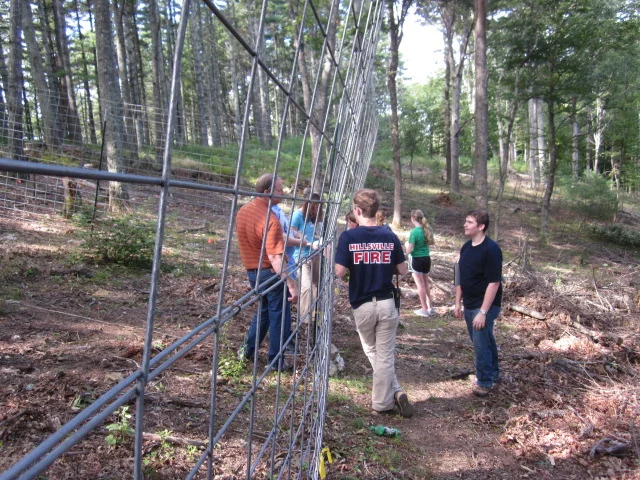Students conduct first survey of Deer Exclosure Plot
Over the course of the last seven years the Matthews State Forest performed proscribed burns to eliminate the white pine understory on this portion of their land holdings. Within that time frame, a forest road was cut through the area. A sixty year old stand of (mostly) white pine sits on the south-west side of the road, and on the north-east side sits a mixed hardwood forest of approximately 80 years maturity. Further management was brought about by thinning some of the hardwoods, opening up the canopy (called shelterwood), with the goal in mind of allowing oak seedlings an opportunity to emerge. All of this occurs on a moderate slope with a north-east aspect, and was not seeded by human hand.
In the thinned hardwood stand, (at latitude 36 degrees, 37’ 39.80”N and longitude 80 degrees, 57’ 17.50”W), a deer exclosure was erected one year ago to study the effect of deer browse on woody growth and its impact on forest regeneration in respects to timber management.
Under Blue Ridge Discovery Center’s direction, a group of Carroll County High School students from Alan Webb’s forestry class (within the AG department) has been recruited to study both the deer plot and adjacent grounds as control plots. Zach Olinger, forester with the MSF, has agreed to play a significant role as this research team collects data from both inside and outside the exclosure.
For our first research day, 9/9/15, the students focused on describing the forest floor and canopy densities, comparing percentages of herbaceous and rocky or barren coverage, taking a census of all the trees within an approximately 80 foot radius of the deer exclosure including diameter, height and species of each tree.






The class of 13 students was broken down into four separate teams. We also had, besides Alan and Zach, Rachelle Rasco, STEM lab teacher from CCHS, Dr. Bill Dunson, retired biology professor, Ayla Wilk, intern from VTech, and Evan Worrell and Scott Jackson-Ricketts from BRDC. The adults split up to assist the four teams with careful plant inventories both within and without the exclosure. Careful notations were taken including the numbers of each species identified within established grids.
During the afternoon session, Zach shared a brief history of the state forest along with descriptions of forest management principles and land use. Evidence of deer browse was noted, along with discussions of wildlife management versus forest management, two distinct approaches led by two distinct state agencies: Virginia Department of Game and Inland Fisheries and Virginia Department of Forestry.
This research program is designed to take place throughout the 2015/2016 school year, with a minimum of four field trip examinations of changes within and without the deer exclosure. Along with the field trips, self-guided learning will take place in the classroom through various media oriented research outlets such as the Internet. The students are to form hypotheses relative to the deer study and submit their conclusions in a professional format at year’s end.